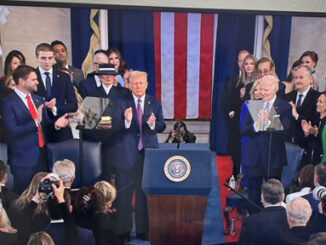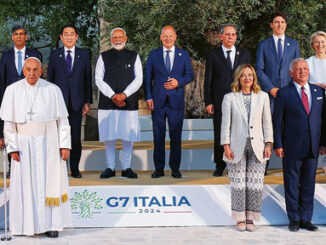
For China, the idea is not to win the trade war by returning to old terms, but to make the war irrelevant by building new coalitions and supply chains that dilute US leverage.
“While Washington and Beijing pause their economic hostilities, America’s allies are left to reassess their own positions amid a shifting balance of trade power. For allies like Japan and the EU, the tariff rollback offers temporary relief but exposes vulnerabilities in their trade-dependent economies. The reset fails to address China’s growing regional influence via RCEP, which now accounts for 30 per cent of global GDP. The EU, exporting over €500 billion euros to the US annually, faces strain from disrupted Chinese imports. Both remain wary of China’s trade diversion tactics, which bolster ASEAN economies at their expense.”

On the face of it, the May 2025 “total reset” in US-China trade relations might appear as a historic de-escalation of one of the most contentious economic confrontations in modern geopolitics. In reality, it may amount to little more than diplomatic show business, as US President Donald Trump often likes to point out. From Beijing’s vantage point, this reset is unlikely to significantly rewire the global trade architecture or alter China’s strategic calculus. If anything, it reinforces a critical trend observed in previous trade conflicts: trade usually finds new channels.
The 90-day suspension of 24 per cent points worth of US tariffs, bringing the effective rate down from a peak of 245 per cent to 10 per cent, may read like détente. China’s reciprocal moderation of its retaliatory tariffs, previously reaching 125 per cent, adds to the narrative of reconciliation.
But under the surface, not much has changed. Neither side has abandoned its zero-sum lens. Both are maneuvering within a relationship marked by interdependence and mutual suspicion. Such resets tend to adjust only tactics not objectives.
To interpret this reset as a fundamental change is to ignore the very structure of US-China trade relations, which have evolved beyond bilateral quirks into a systemic economic interlock.
Pre-2025, bilateral trade volumes surpassed $600 billion annually, with a US goods trade deficit of $295 billion. Such figures are the outcome of decades of integrated supply chains and comparative advantage. A 90-day tariff rollback does not unwind them, nor does it address core ideological clashes around China’s state capitalism, intellectual property enforcement or industrial subsidies.
From Beijing’s perspective, the real measure of the “reset” is its marginal utility in reducing near-term economic pain, not a gateway to restored trade normalcy, and even that is debatable. For a while, China has been battered by the cumulative effects of Trump’s tariffs, but the country has proven adept at absorbing external shocks. It has turned to monetary tools, slashed interest rates and funneled liquidity into its banking system, even as exports continued rising in April, driven largely by trade redirection.
It is difficult to assess the reset without revisiting the Trump-era tariff policy that preceded it. The rationale was to force structural reforms in China’s economic behavior by inflicting economic pain through extreme tariffs. The cost, however, has been largely borne by American households and producers. The Tax Foundation estimates a 1.3-per cent hit to long-run US GDP.
Moreover, even as the US sought to punish China, its own exporters, especially in agriculture, suffered $27 billion in retaliatory losses between 2018 and 2019 alone. In scaling up these tariffs in 2025, Trump did more than revive a failed strategy; he escalated a cycle that inflicted widespread collateral damage. While the Geneva talks may validate that this pressure forced Beijing to the table, they equally underscore the limitations of using blunt-force tariffs to negotiate complex systemic issues.
China, for its part, never engaged in a purely retaliatory tit-for-tat. It leaned into diversionary strategies, using third-party states to maintain trade continuity, and deepened regional integration through initiatives like the RCEP.
Nowhere is this adaptation more evident than in Vietnam. During the 2018-2019 trade war, Vietnamese exports to the US surged from $47.58 billion to $136.6 billion by 2024. A closer inspection reveals a more intricate picture. Roughly 16 per cent of these exports were, in fact, rerouted Chinese goods, using Vietnam as an intermediary to circumvent tariffs. The irony is that China, while ostensibly under siege, leveraged its own regional supply networks to retain market access.
This pattern has only deepened in the current trade climate. China understood that while direct trade could be throttled, the architecture of global commerce would inevitably recalibrate and, often, to its benefit.
Also, this diversion does not represent a net loss for global trade. Rather, it reflects its re-routing. When Trump weaponized tariffs to contain China, he did not so much dam the river as force it into new tributaries. And in doing so, he ceded leverage to emerging markets, expanded the influence of China’s supply-side diplomacy and created conditions where bilateral punishment had global spillover effects.
Despite the tariffs and counter-measures, the basic trade baskets between the US and China have remained relatively intact. China remains the US’ second-largest export market and the US remains China’s top destination. The notion of a “decoupling” is a political fantasy; economically, it is infeasible.
The Geneva talks did not produce a new framework, nor did they introduce mechanisms for long-term stability. They merely bought time. The temporary tariff suspension is less about reversing policy and more about acknowledging mutual economic pain.
For China, this is not a strategic retreat. It is a pragmatic pause. Its leadership likely sees this reset as a reprieve to consolidate alternative routes through ASEAN, Africa or the Global South. The idea is not to win the trade war by returning to old terms, but to make the war irrelevant by building new coalitions and supply chains that dilute US leverage.
While Washington and Beijing pause their economic hostilities, America’s allies are left to reassess their own positions amid a shifting balance of trade power. For allies like Japan and the EU, the tariff rollback offers temporary relief but exposes vulnerabilities in their trade-dependent economies. The reset fails to address China’s growing regional influence via RCEP, which now accounts for 30 per cent of global GDP. The EU, exporting over €500 billion euros to the US annually, faces strain from disrupted Chinese imports. Both remain wary of China’s trade diversion tactics, which bolster ASEAN economies at their expense.
Conversely, countries hostile to the US seize opportunities amid the chaos. Russia, redirecting 47 per cent of its $62.4 billion in 2024 oil exports to China, leverages Beijing’s pivot to non-Western markets, reducing its reliance on European buyers post-Ukraine sanctions. Iran, with $20 billion in covert trade with China, exploits tariff-driven gaps to funnel oil through proxies like Malaysia, evading US sanctions.
India, nominally US-aligned but non-aligned in practice, navigates a dual-edged sword. India’s trade deficit with China widened to a record $99.2 billion in 2024-25, underscoring its reliance on Chinese imports for critical components, even as trade dynamics with the US continue to evolve. The reset offers breathing room but leaves it balancing US pressure against China’s economic pull.
Ultimately, the fiasco amplifies global trade’s fragmentation, forcing allies to hedge and adversaries to exploit, with no clear winners beyond the architects of rerouted commerce.
The US-China reset of 2025 temporarily halts a downward spiral but fails to resolve the fundamental disconnects that have driven bilateral friction. More crucially, it fails to reshape the broader world trade order in any meaningful way. Trade, once disrupted, simply recalibrates.
China understands this better than most. Its resilience in the face of tariffs, its ability to reroute trade through Vietnam and Southeast Asia and its structural reliance on interdependence over confrontation — they all point to a state that is less interested in fighting back than in flowing around obstacles.
So, in the real game of geoeconomics, it’s not about who resets the board, it’s about who learns to play the game differently. From Beijing’s view, it seems the game has already moved beyond Washington’s rules.
(Deepanshu Mohan is Dean, OP Jindal Global University)





Be the first to comment